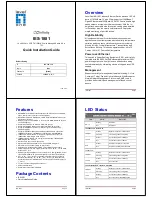
22-15
To do…
Use the command…
Remarks
Configure the destination port
destination port
port-number
Required
By default, no destination port number
is configured for a test operation.
The destination port number must be
the port number of the listening service
configured on the NQA server.
Configure the size of probe
packets sent
data-size
size
Optional
100 bytes by default.
Configure the filler string of a
probe packet sent
data-fill
string
Optional
By default, the filler string of a probe
packet is the hexadecimal number
00010203040506070809.
Specify a source port number
for a probe request in a test
operation
source port
port-number
Optional
By default, no source port number is
specified.
Configure the source IP
address of a probe request in a
test operation
source ip ip-address
Optional
By default, no source IP address is
specified.
The source IP address must be that of
an interface on the device and the
interface must be up. Otherwise, the
test will fail.
Configure common optional
parameters
See
Configuring
Optional Parameters
Common to an NQA
Test Group
Optional
Configuring a Voice Test
It is recommended not to perform an NQA UDP jitter test on known ports, namely, ports from 1 to 1023.
Otherwise, the NQA test will fail or the corresponding services of these ports will be unavailable.
A voice test is used to test voice over IP (VoIP) network status, and collect VoIP network parameters so
that users can adjust the network according the network status. The procedure of a voice test is as
follows:
1) The source (NQA client) sends voice packets of G.711 A-law, G.711 µ-law or G.729 A-law codec
type at regular intervals to the destination (NQA server).
2) The destination affixes a time stamp to each packet that it receives and then sends it back to the
source.
3) Upon receiving the packets, the source calculates the delay jitter and delay by calculating the
difference between the interval for the destination to receive two successive packets and the
















































